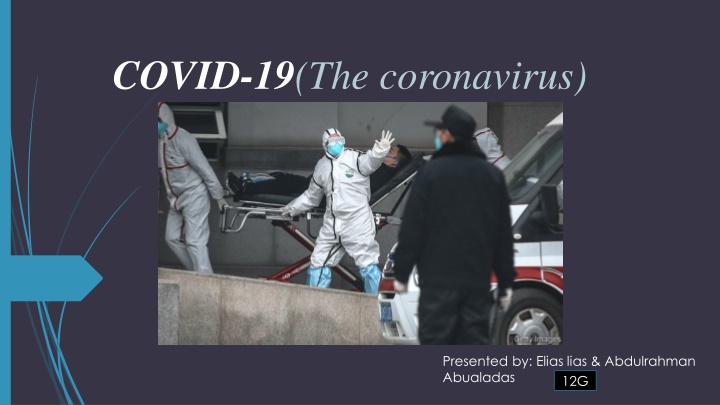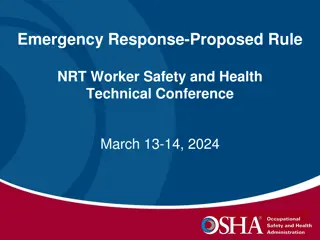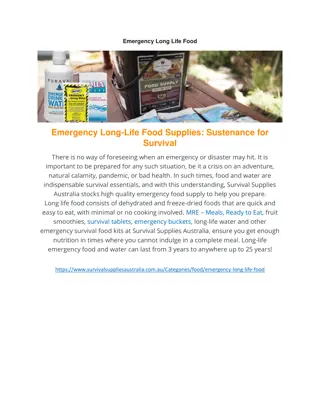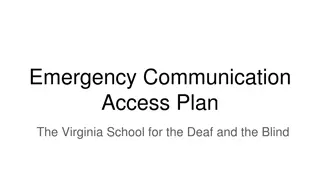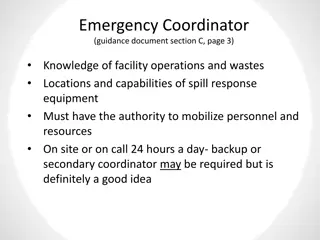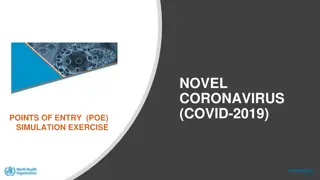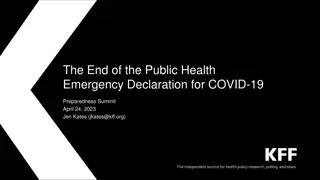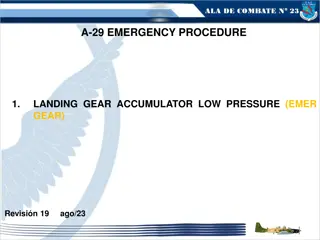COVID-19: A Global Health Emergency
A novel coronavirus, named 2019-nCoV, has caused a global health emergency since its identification in Wuhan, China. Coronaviruses, characterized by their crownlike shape, can infect both animals and humans, leading to respiratory symptoms and potentially severe complications. The virus spreads through respiratory droplets, and the body's immune response, while crucial for fighting the infection, can also cause collateral damage. Learn more about COVID-19 and how it affects the immune system's response.
Download Presentation

Please find below an Image/Link to download the presentation.
The content on the website is provided AS IS for your information and personal use only. It may not be sold, licensed, or shared on other websites without obtaining consent from the author.If you encounter any issues during the download, it is possible that the publisher has removed the file from their server.
You are allowed to download the files provided on this website for personal or commercial use, subject to the condition that they are used lawfully. All files are the property of their respective owners.
The content on the website is provided AS IS for your information and personal use only. It may not be sold, licensed, or shared on other websites without obtaining consent from the author.
E N D
Presentation Transcript
COVID-19(The coronavirus) Presented by: Elias lias & Abdulrahman Abualadas 12G
Introduction A novel coronavirus, previously designated 2019-nCoV, was identified as the cause of a cluster of pneumonia cases in Wuhan, a city in the Hubei Province of China, at the end of 2019. It subsequently spread throughout China and elsewhere, becoming a global health emergency. In February 2020, the World Health Organization (WHO) designated the disease COVID-19, which stands for coronavirus disease 2019.
What, exactly, is the coronavirus? Coronaviruses, named for their crownlike shape, are a large family of viruses that are common in many species of animals. There are also several coronaviruses that can infect people, according to the Centres for Disease Control and Prevention (CDC). These strains mostly cause cold-like symptoms but can sometimes progress to more complicated lower respiratory tract illnesses, such as pneumonia or bronchitis. On rare occasion, animal coronaviruses can evolve and spread among humans, as seen with Middle Eastern respiratory syndrome coronavirus (MERS-CoV) and severe acute respiratory syndrome coronavirus (SARS-CoV). The virus at the center of the latest outbreak is being referred to as a novel (new) coronavirus (or 2019-nCoV for short), since it's something that health officials have not seen before. Coronaviruses are zoonotic, meaning they are transmitted between animals and people.
What are the symptoms? Common signs of infection include respiratory symptoms, fever, cough, shortness of breath and breathing difficulties. In more severe cases, infection can cause pneumonia, severe acute respiratory syndrome, kidney failure and even death.
How is the coronavirus spreading? Health officials are still trying to better understand how 2019-nCoV is spreading among people. But when person-to-person transmission occurred with MERS and SARS, respiratory droplets from coughs and sneezes were the likely culprit, according to the CDC. It s said to be originally started to spread from animals to humans through bats or snakes in restaurants.
How the immune system responses to the coronavirus? With any infection, the body s immune system responds by attacking the foreign virus or bacteria. While this immune response can rid the body of the infection, it can also sometimes cause collateral damage in the body. This can come in the form of an intense inflammatory response, sometimes called a cytokine storm. The immune cells produce cytokines to fight infection, but if too many are released, it can cause problems in the body. The infection itself can generate an intense inflammatory response in the body that can affect the function of multiple organ systems This damage to the organs isn t always directly caused by the infection, but can result from the body s response to infection.
As of Feb 27th.
What are the best ways to protect myself? Avoid touching your eyes, nose and mouth with unwashed hands, and steer clear of other sick people. Avoid close contact with people suffering from acute respiratory infections. Avoid close contact with people suffering from acute respiratory infections. Avoid unprotected contact with farm or wild animals. Wear face masks for extra protection.
Face masks A facemask is a loose-fitting, disposable device that creates a physical barrier between the mouth and nose of the wearer and potential contaminants in the immediate environment.
N95 Respirators An N95 respirator is a respiratory protective device designed to achieve a very close facial fit and very efficient filtration of airborne particles. N95 mask offers 50% lesser breathing resistance than N99. It means you can wear the N95 mask for longer duration without feeling suffocated.
Prevention is better than cure 1. The first step that anyone has to consider in order to prevent any type of disease is improving there immune system. So how could you improve your immune system? Don't smoke. Eat a diet high in fruits and vegetables. Exercise regularly. Maintain a healthy weight. Get adequate sleep.
Best type of foods to develop your immune system. Full filled vitamin C fruits. Tea. Mushrooms. Acai Berry. Super Spinach. All type of vitamin D products.
Is it going to kill you? The most asked question, about corona virus that whether it kills someone immediately or not. The answer is don t panic it wont, by taking all the steps to improve your immune system even if the virus reaches you, you will easily get cured as it s a normal Flu The percentage of people died from coronavirus is just 2.1% it occurred to those who have A very weak immune system, Old age, or still very young that their immune system is not yet fully developed.
Resources https://abcnews.go.com/International/death-toll-coronavirus-rises-106- china-outbreak-spreads/story?id=68580575 https://www.thelancet.com/journals/lancet/article/PIIS0140-6736(20)30260- 9/fulltext#seccestitle160 https://www.aarp.org/health/conditions-treatments/info-2020/coronavirus- facts.html https://www.who.int/health-topics/coronavirus https://www.who.int/docs/default-source/coronaviruse/situation- reports/20200208-sitrep-19-ncov.pdf?sfvrsn=6e091ce6_2
